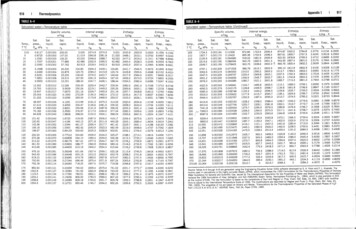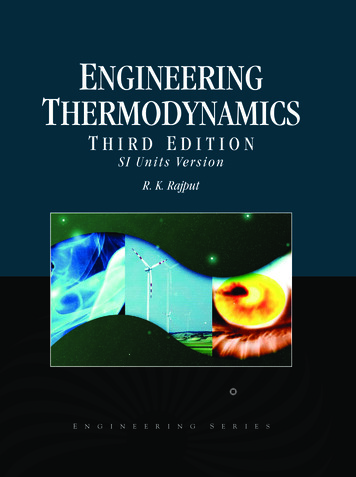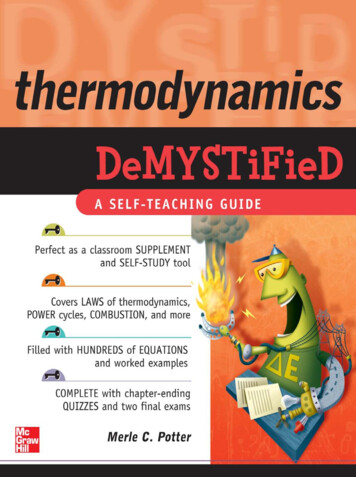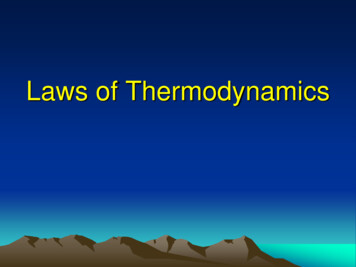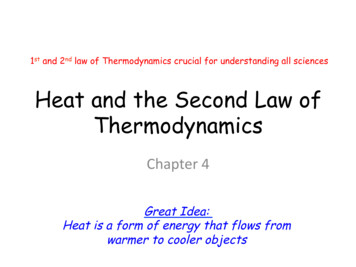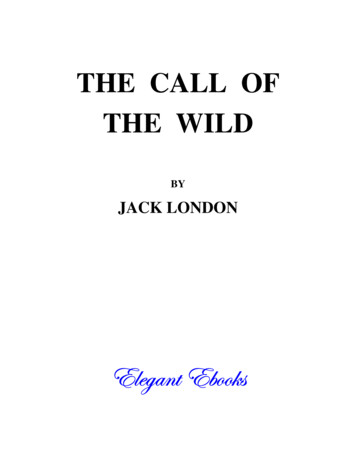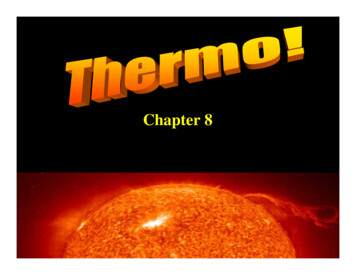
Transcription
Chapter 8
TemperatureTemperature a number that corresponds to the warmth orcoldness of an object measured by a thermometer is a per-particle property no upper limit definite limit on lower end
TemperatureTemperature Scale Celsius scale named after Anders Celsius (1701–1744)– zero C for freezing point of water to 100 C for boilingpoint of water Fahrenheit scale named after G. D. Fahrenheit(1686–1736)– 32 F for freezing point of water to 212 F for boiling pointof water Kelvin scale named after Lord Kelvin (1824–1907)for freezing point of water to 373 K for boilingpoint of water– zero at absolute zero, same size degrees as Celsius scale– Kelvins, rather than degrees are used0K
TemperatureTemperature is proportional to the averagetranslational kinetic energy per particle in asubstance. gas—how fast the gas particles are bouncing toand fro liquid—how fast particles slide and jiggle pastone another solid—how fast particles move as they vibrateand jiggle in place
Gas Particles are in constant RANDOM motion Particles have different speeds Pressure is given by the momentum transferred by particles colliding Average KE of each particle is T
The Internal Energy of a system is a measure of the total Energy due toALL random molecular motions: (Translations KE, Rotational KE,Vibrational KE) and internal POTENTIAL energies due to interactiveforces (electromagnetic, strong, weak, gravitational) Mechanical Energy is due to the kinetic and potential energies of thesystem itself in an external reference frame. Temperature is a measure of the AVERAGE Translational KE ONLY! Heat is a flow of thermal energy from hotter to colder because of adifference in temperature. (think water fall!)
TemperatureCHECK YOUR NEIGHBORThere is twice as much molecular kinetic energy in 2 liters ofboiling water as in 1 liter of boiling water. Which will be thesame for both?A.B.C.D.temperaturethermal energyboth A and Bneither A nor B
TemperatureCHECK YOUR ANSWERThere is twice as much molecular kinetic energy in 2 liters ofboiling water as in 1 liter of boiling water. Which will be thesame for both?A.B.C.D.temperaturethermal energyboth A and Bneither A nor BExplanation:Average kinetic energy of molecules is the same, which meanstemperature is the same for both.
TemperatureCHECK YOUR NEIGHBORTo say that body A has a higher temperature than body B is tosay that body A has moreA.B.C.D.thermal energy.mass.kinetic energy per particle.potential energy.
TemperatureCHECK YOUR ANSWERTo say that body A has a higher temperature than body B is tosay that body A has moreA.B.C.D.thermal energy.mass.kinetic energy per particle.potential energy.
HeatHeat internal energy transferred from one thing to another due toa temperature difference internal energy in transitFlow of Internal Energy from a high-temperature substance to a low-temperaturesubstance until thermal equilibrium is reached internal energy never flows unassisted from a lowtemperature to a high-temperature substance
HeatCHECK YOUR NEIGHBORIf a red hot thumbtack is immersed in warm water, the directionof heat flow will be from theA.B.C.D.warm water to the red hot thumbtack.red hot thumbtack to the warm water.no heat flownot enough information
HeatCHECK YOUR ANSWERIf a red hot thumbtack is immersed in warm water, the directionof heat flow will be from theA.B.C.D.warm water to the red hot thumbtack.red hot thumbtack to the warm water.no heat flownot enough information
Quantity of HeatEnergy ratings of foods and fuels are determined fromenergy released when they are burned.Unit of energy, the Calorie, is common for foods.4.18 joules 1 calorie 4.18 joules of heat are required to change the temperature of 1gram of water by 1 Celsius degree kilocalorie or 1000 calories called aCalorie heat needed to change the temperatureof 1 kg of water by 1 C
Quantity of HeatCHECK YOUR NEIGHBORThe same quantity of heat is added to different amounts of waterin two equal-size containers. The temperature of the smalleramount of waterA.B.C.D.decreases more.increases more.does not change.not enough information
Quantity of HeatCHECK YOUR ANSWERThe same quantity of heat is added to different amounts of waterin two equal-size containers. The temperature of the smalleramount of waterA.B.C.D.decreases more.increases more.does not change.not enough information
Quantity of HeatCHECK YOUR NEIGHBORYou heat a half-cup of tea and its temperature rises by 4 C. Howmuch will the temperature rise if you add the same amount ofheat to a full cup of tea?A.B.C.D.0 C2 C4 C8 C
Quantity of HeatCHECK YOUR ANSWERYou heat a half-cup of tea and its temperature rises by 4 C. Howmuch will the temperature rise if you add the same amount ofheat to a full cup of tea?A.B.C.D.0 C2 C4 C8 C
Specific Heat: Thermal InertiaThe Specific Heat of a substance is the amount of Energy itrequires to raise the temperature of 1 gram, 1 degree Celsius.Q mcΔTQJc mΔT kg 0C The higher the specific heat, the more energy it takes and thelonger it takes to heat up and to cool off. The lower the specific heat, the less energy it takes and thequicker it takes to heat up and cool off. Substances with HIGH specific heat STORE heat energy andmake good thermal moderators. (Ex: Water, Oceans)
Specific HeatJcwater 41860kg CJcglycerin 2410kg 0CJciron 452kg 0CWhy does water have such a highspecific heat?Heat goes into other modes of energy so thattemperature changes slowly.
Specific Heat CapacityCHECK YOUR NEIGHBORWhich has the higher specific heat capacity, water or land?A.B.C.D.Water.Land.both of the above are the sameneither of the above
Specific Heat CapacityCHECK YOUR ANSWERWhich has the higher specific heat capacity, water or land?A.B.C.D.Water.Land.both of the above are the sameneither of the aboveExplanation:A substance with small temperature changes for large heat changes has ahigh specific heat capacity. Water takes much longer to heat up in thesunshine than does land. This difference is a major influence on climate.
The Laws of ThermodynamicsThermodynamics movement of heatFirst law of thermodynamics states that the heat added to a system transforms toan equal amount of some other form of energy more specifically, heat added increase internalenergy external work done by the system Energy can neither be created nor destroyed.
Zeroeth Law Two systems individually in thermalequilibrium with a third system (such as athermometer) are in thermal equilibriumwith each other. That is, there is no flow of heat within asystem in thermal equilibrium
1st Law of Thermo The change of internal energy of a systemdue to a temperature or phase change isgiven by (next chapter):Temperature Change: Q mcΔTPhase Change: Q mL Q is positive when the system GAINS heatand negative when it LOSES heat.
2nd Law of Thermo Heat flows spontaneously from a substanceat a higher temperature to a substance at alower temperature and does not flowspontaneously in the reverse direction. Heat flows from hot to cold. Alternative: Irreversible processes musthave an increase in Entropy; Reversibleprocesses have no change in Entropy. Entropy is a measure of disorder in a system
3rd Law of ThermoIt is not possible tolower thetemperature of anysystem to absolutezero.
Absolute ZeroAs temperature of a gas changes, volume of agas changes. at zero degrees with pressure constant, volume changes by1/273 for each degree CelsiusAbsolute Zero lowest limit of temperature molecules have lost all available kinetic energy
Thermal Expansion: Linear
Thermal ExpansionThermal expansion due to rise in temperature of a substance, molecules jigglefaster and move farther apart most substances expand when heated and contract whencooled– railroad tracks laid on winter days expand and buckle inhot summer– warming metal lids on glass jars under hot waterloosens the lid by more expansion of the lid than the jar
Thermal ExpansionThermal expansion (continued) plays a role in construction and devicesexample: use of reinforcing steel with the same rate of expansion asconcrete—expansion joints on bridges gaps on concrete roadways and sidewalks allow forconcrete expansion in the summer and contraction in thewinter
Thermal ExpansionThermal expansion (continued) different substances expand at different ratesexample: when the temperature of a bimetallic strip of brass and ironis increased, greater expansion occurs for the brass stripthat bends to turn a pointer, to regulate a valve, or to close aswitchBimetallic strips are used in heaters, oven thermometers,refrigerators, and electric toasters.
Thermal ExpansionCHECK YOUR NEIGHBORWhen stringing telephone lines between poles in the summer, it isadvisable to allow the lines toA.B.C.D.sag.be taut.be close to the ground.allow ample space for birds.
Thermal ExpansionCHECK YOUR ANSWERWhen stringing telephone lines between poles in the summer, it isadvisable to allow the lines toA.B.C.D.sag.be taut.be close to the ground.allow ample space for birds.Explanation:Telephone lines are longer in a warmer summer and shorter in a cold winter. Hence, theysag more on hot summer days than in winter. If the lines are not strung with enough sag insummer, they might contract too much and snap during the winter—especially whencarrying ice.
Thermal ExpansionΔL α L0 ΔTΔV βV0 ΔT Coefficients determined experimentally! Liquids expand more than solids! β 3α
Thermal Expansion: LinearThe coefficient of linear expansion of steel is 12 x 10-6/ C.A railroad track is made of individual rails of steel 1.0 km in length.By what length would these rails change betweena cold day when the temperature is -10 C and a hot day at 30 C?ΔL α L0 ΔT 6ΔL (12 x10 / C )(10 m)(30 C ( 10 C ))o3ΔL .48moo
Thermal ExpansionWhen the temperature of a metal ring increases,does the hole become larger?Smaller? Or stay same?
Circle ExpansionThe coefficient of linearexpansion of aluminum is23 x 10-6/C . A circularhole in an aluminum plate is2.725 cm in diameter at 0 C.What is the diameter of thehole if the temperature ofthe plate is raised to 100 C?ΔL α L0 ΔT 6 oo (23 x10 / C )(2.725cm)100 C 3 6.3 x10 cmd 2.731cm
Thermal Expansion: WaterWater Expands when it cools below 4 C !Thus, the solid state is less dense than the liquid state:
Thermal ExpansionCHECK YOUR NEIGHBORWhen a sample of 0 C water is heated, it firstA.B.C.D.expands.contracts.remains unchanged.not enough information
Thermal ExpansionCHECK YOUR ANSWERWhen a sample of 0 C water is heated, it firstA.B.C.D.expands.contracts.remains unchanged.not enough informationExplanation:Water continues to contract until it reaches a temperature of 4 C. Withfurther increase in temperature beyond 4 C, water then expands.
Thermal ExpansionCHECK YOUR NEIGHBORWhen a sample of 4 C water is cooled, itA.B.C.D.expands.contracts.remains unchanged.not enough information
Thermal ExpansionCHECK YOUR ANSWERWhen a sample of 4 C water is cooled, itA.B.C.D.expands.contracts.remains unchanged.not enough informationExplanation:Parts of the water will crystallize and occupy more space.
You heat a half-cup of tea and its temperature rises by 4 C. How . 6.3 10xcm 3 dcm 2.731. Thermal Expansion: Water Water Expands when it cools below 4 C ! Thus, the solid state is less dense than the liquid state: W
